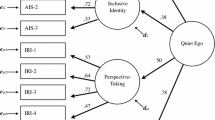Abstract
This study distinguished between forms of self-consciousness (private self-consciousness and social anxiety) and investigated the effect of self-esteem, vulnerability to criticism, and the tendency to fantasize on each. Utilizing a sample of adolescents (age 12 to 19 years), a structural equation analysis using unobserved variables revealed that, as expected, vulnerability to others' criticism heightened both private self-consciousness and social anxiety. In contrast, the tendency to fantasize in everyday life increased only private self-consciousness, and low self-esteem led directly only to increased social anxiety. Further, results showed that self-esteem had an appreciable indirect effect on both private self-consciousness and social anxiety, as mediated by vulnerability and the tendency to fantasize, indicating that the effect of self-esteem (a primary motivator) was more complex than an analysis of direct effects would indicate. Implications for our understanding of self-consciousness and the self-concept are discussed.
Similar content being viewed by others
References
Allport, G. (1961).Pattern in Growth and Personality Holt, Rinehart and Winston, New York.
Alwin, D. F., and Hauser, R. M. (1975). The decomposition of effects in path analysis.Am. Sociol. Rev. 40: 37–47.
Argyle, M. (1969).Social Interaction Tavistock, London.
Blumer, H. (1969).Symbolic Interactionism Prentice-Hall, Englewood Cliffs, N.J.
Buss, A. H. (1980).Self-Consciousness and Social Anxiety W. H. Freeman, San Francisco.
Buss, A. H., and Scheier, M. F. (1976). Self-consciousness, self-awareness, and self-attribution.J. Res. Personal. 10: 463–468.
Cooley, C. H. (1902).Human Nature and the Social Order Scribner's, New York.
Duval, S., and Wicklund, R. A. (1972).A Theory of Objective Self-Awareness Academic Press, New York.
Elliott, G. C. (1982). Self-esteem and self-presentation among the young as a function of age and gender.J. Youth Adoles. 11: 135–155.
Elliott, G. C., Rosenberg, M., and Wagner, M. (1984). Transient depersonalization in youth.Soc. Psychol. Q. 47: 115–129.
Fenigstein, A., Scheier, M. F., and Buss, A. H. (1975). Public and private self-consciousness: Assessment and theory.J. Consult. Clin. Psychol. 43: 522–527.
Hauser, R. M., and Goldberger, A. S. (1971). The treatment of unobservable variables in path analysis. In Costner, H. L. (ed.),Sociological Methodology 1971 Jossey-Bass, San Francisco, pp. 81–117.
Jahoda, M. (1958).Current Concepts of Positive Mental Health Basic Books, New York.
James, W. (1890/1950).The Principles of Psychology (reprint), Dover, New York.
Joreskog, K. G. (1978). Structural analysis of covariance and correlation matrices.Psychometrika 43: 443–447.
Joreskog, K. G. (1979). Structural equation models in the social sciences: Specification, estimation, and testing. In Joreskog, K. G., and Sorbom, D. (eds.),Advances in Factor Analysis and Structural Equation Models Abt Books, Cambridge, Mass., pp. 105–127.
Joreskog, K. G., and Sorbom, D. (1981).Lisrel: Analysis of Linear Structural Relationships by the Method of Maximum Likelihood Version V, National Education Resources, Chicago.
Kaplan, H. B. (1975).Self-Attitudes and Deviant Behavior Goodyear, Pacific Palisades, Calif.
LaSorte, M. A. (1972). Replication as a verification technique in survey research: A paradigm.Sociol. Q. 13: 218–227.
Mead, G. H. (1934).Mind, Self, and Society University of Chicago Press, Chicago.
McGuire, W. J., and Padawer-Singer, A. (1976). Trait salience in the spontaneous self-concept.J. Personal. Soc. Psychol. 33: 743–754.
Murphy, G. (1947).Personality Harper, New York.
Random House Dictionary (revised ed.) (1975). Random House, New York.
Rosenberg, M. (1965).Society and the Adolescent Self-Image Princeton University Press, Princeton, N.J.
Rosenberg, M. (1979).Conceiving the Self Basic Books, New York.
Rosenberg, M., and Simmons, R. G. (1972).Black and White Self-Esteem: The Urban Schoolchild Rose Monograph Series, The American Sociological Association, Washington, D.C.
Scheier, M. F., Buss, A. H., and Buss, D. M. (1978). Self-consciousness, self-report of aggressiveness, and aggression.J. Res. Personal. 12: 133–140.
Schwartz, M., and Stryker, S. (1971).Deviance, Selves, and Others Rose Monograph Series, The American Sociological Association, Washington, D.C.
Stryker, S. (1968). Identity salience and role performance: The relevance of symbolic interaction theory for family research.J. Marriage Family 30: 558–564.
Turner, R. G., and Peterson, M. (1977). Public and private self-consciousness and emotional expressivity.J. Consult. Clin. Psychol. 45: 490–491.
Turner, R. G., Scheier, M. F., Carver, C. S., and Ickes, W. (1978). Correlates of self-consciousness.J. Personal. Assess. 42: 285–289.
Wells, L. E., and Marwell, G. (1976).Self-Esteem: Its Conceptualization and Measurement Sage, Beverly Hills, Calif.
Wicklund, R. A. (1975). Objective self-awareness. In Berkowitz, L. (ed.),Advances in Experimental Social Psychology, Vol. 8 Academic Press, New York, pp. 233–275.
Wiley, D. E. (1983). The identification problem for structural equation models with unobserved variables. In Goldberger, A. S., and Duncan, O. D. (eds.),Structural Equation Models in the Social Sciences Seminar Press, New York, pp. 69–83.
Wiley, R. (1979).The Self-Concept: Revised Edition, Vol. 2, Theory and Research on Selected Topics University of Nebraska Press, Lincoln.
Author information
Authors and Affiliations
Additional information
My deepest thanks go to Morris Rosenberg, whose insights into the self-concept were indispensable, both in conceptualization and in analysis. I also thank John A. Fleishman and Edward Z. Dager for their constructive comments on early drafts of this article. Any errors remaining are my responsibility.
This study was supported by NIMH Grant R01 MH27747-06 awarded to Morris Rosenberg. The data were analyzed using the facilities of the Computer Science Center, University of Maryland, College Park.
Professor Elliott received his Ph.D. in sociology at the University of Wisconsin, Madison. His current major interest is in the structure of the self-concept.
Rights and permissions
About this article
Cite this article
Elliott, G.C. Dimensions of the self-concept: A source of further distinctions in the nature of self-consciousness. J Youth Adolescence 13, 285–307 (1984). https://doi.org/10.1007/BF02094866
Received:
Accepted:
Issue Date:
DOI: https://doi.org/10.1007/BF02094866




